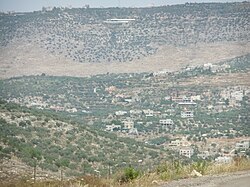Kafr Rumman (Arabic: كفر رمّان) is a Palestinian town in the Tulkarm Governorate in the eastern West Bank, located 11 kilometers East of Tulkarm. According to the Palestinian Central Bureau of Statistics, Kafr Rumman had a population of approximately 869 inhabitants in mid-year 2007.[2]
Kafr Rumman
| |
|---|---|
| Arabic transcription(s) | |
| • Arabic | كفر رمّان |

| |
|
Location of Kafr Rumman within Palestine | |
| Coordinates: 32°19′01″N 35°07′36″E / 32.31694°N 35.12667°E / 32.31694; 35.12667 | |
| Palestine grid | 162/191 |
| State | State of Palestine |
| Governorate | Tulkarm |
| Government | |
| • Type | Municipality |
| Population
(2007)
| |
| • Total | 869 |
| Name meaning | The village of the pomegranates (=Rimmon)[1] |
Potsherd from the Middle Bronze Age IIB,[3] Iron Age II,[3] Persian,[3] Hellenistic,[3] Roman,[3][4] Byzantine[3][4] and early Muslim eras have been found here.[3]
Kafr Rumman, like all of Palestine was incorporated into the Ottoman Empire in 1517. In the 1596 tax registers, it was part of the nahiya ("subdistrict") of Jabal Sami, part of the larger Sanjak of Nablus. It had a population of 20 households, all Muslims. The inhabitants paid a fixed tax rate of 33,3% on agricultural products, including wheat, barley, summer crops, olive trees, goats and beehives, in addition to occasional revenues and a press for olive oil or grape syrup, and a fixed tax for people of Nablus area; a total of 3,022 akçe.[5]
The old core of the village is presumed to have been built in the 16th-17th century CE, and contains high, fortified buildings.[3]
In 1838 Kefr Rumman was placed in the Wady esh-Sha'ir administrative region, west of Nablus.[6]
In 1870 Victor Guérin noted it from nearby Ramin.[7]
In 1870/1871 (1288 AH), an Ottoman census listed the village in the nahiya (sub-district) of Wadi al-Sha'ir.[8]
In 1882 the PEF's Survey of Western Palestine (SWP) described Kefr Rumman as: "a small hamlet on the side of the mountain, with a well to the north and olives."[9]
In the 1922 census of Palestine conducted by the British Mandate authorities, Kufr Rumman had a population of 161 Muslims,[10] increasing in the 1931 census to 189 Muslims, in 48 houses.[11]
In the 1945 statistics the population of Kafr Rumman was 270 Muslims,[12] with 3,933 dunams of land according to an official land and population survey.[13] Of this, 625 dunams were plantations and irrigable land, 352 were used for cereals,[14] while 5 dunams were built-up (urban) land.[15]
In the wake of the 1948 Arab–Israeli War, and after the 1949 Armistice Agreements, Kafr Rumman came under Jordanian rule.
In 1961, the population was 466.[16]
Since the Six-Day War in 1967, Kafr Rumman has been under Israeli occupation. In 1997, Kafr Rumman had a population of 649, of whom 45.5% were registered refugees.[17]